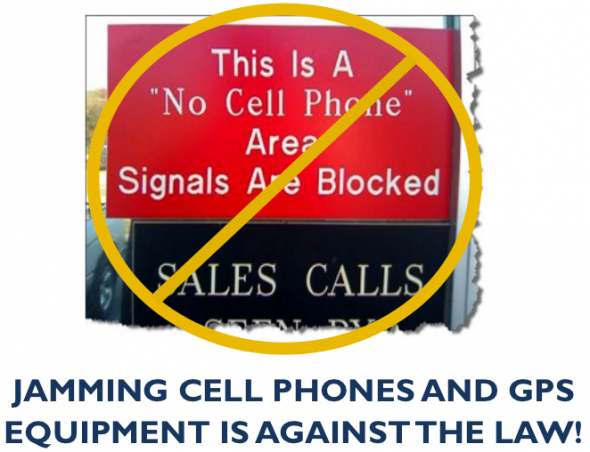If you think you are looking to buy a GPS jammer you need to think again. According to the FCC and Federal law it is illegal to use, sell or even market these devices in the United States. For some people who suspect that they are the subject of illegal GPS tracking activity, this leaves them with one less option to fight against a stalker or other criminal activity. But in the interest of public safety the complete prohibition of these devices has been deemed necessary by the powers that be. Whether or not you agree with this, it is the law and you should probably look for another solution to take care of your illegal GPS tracking problem.
Why Is Owning a GPS Jammer Illegal?
A person looking to buy a GPS tracking jammer to help thwart illegal activity by the US government or by a private citizen could feel as though a law preventing them from doing so is stupid. They are just trying to protect themselves; isn’t that okay? The powers that be, however, have deemed the use, sale and marketing of such jamming devices illegal (except by the US government – a little ironic, don’t you think). The Department of Homeland Security is ramping up efforts to identify sources of jamming activity and prosecute those who are using these devices. Just take a look at these statements by government officials and laws:
Communications Act of 1934, as amended, 47 U.S.C. §§ 301, 302a(b), 333.
- Section 301 of the Communications Act: “No person shall use or operate any apparatus for the transmission of energy or communications or signals by radio…except under and in accordance with [the Communications] Act and with a license in that behalf granted under the provisions of this Act.†47 U.S.C. § 301.
- Section 302(b) of the Communications Act: “No person shall manufacture, import, sell, offer for sale, or ship devices or home electronic equipment and systems, or use devices, which fail to comply with regulations promulgated pursuant to this section.†47 U.S.C. § 302a(b).
- Section 333 of the Communications Act: “No person shall willfully or maliciously interfere with or cause interference to any radio communications of any station licensed or authorized by or under [the Communications] Act or operated by the United States Government.†47 U.S.C. § 333.
“Jamming devices create serious safety risks. In the coming weeks and months, we’ll be intensifying our efforts through partnerships with law enforcement agencies to crack down on those who continue to violate the law. Through education, outreach, and aggressive enforcement, we’re tackling this problem head on.”
— P. Michele Ellison, Chief, Enforcement Bureau
Jammers are definitely illegal and the government is taking an increasing interest in suppressing their use.
The main reason cited by the government is that jammers of all kinds pose a risk to public safety. The rational goes something like this:
Jammers are indiscriminate blockers. Since jammers are unable to determine if a phone call or GPS device is being used for emergency purpose or for a social one, they pose a risk to all citizens. The key here is that they are indiscriminate. Just imagine if you have a jammer set up in your store, home or car. You might have the jammer there for perfectly legitimate reasons, like preventing someone from tracking you while at work, at home or on the road. But these jammers have no way of blocking just your device. Someone in the store could have a heart attack, or your next door neighbor might cut themselves with a knife, or your vehicle could get in an accident. If the jammer is powerful enough you run the risk of preventing the legitimate use of communication signals for emergency purposes. You are now posing a risk to the world around you.
Jammers can also wreak havoc on important national infrastructure. The DHS is beginning to take this very seriously. Just take a look at the slides of their presentation (.pdf) at the 2012 Telcordia-NIST-ATIS Workshop on Synchronization in Telecommunication Systems (WSTS ’12), held March 20-22, 2012, in Broomfield, Colorado. While some of the jamming equipment outline in this presentation offer a significant leap over most GPS jamming equipment found through a simple Google search, the risk to financial, power, telecommunications and transportation infrastructure is significant.
With that being said, you really should think twice about getting a jammer.
More Government Resources:
Is My GPS Jammer Illegal?
What about those who have already bought a device marketed as a GPS jammer? How does a person tell if the jammer is legal or illegal?
The easiest way to tell is to identify FCC ID label your device. If it does not have the important FCC ID then you should stop using your device because it is probably illegal to use.
If you need help finding the FCC ID on your device you might find this helpful: FCC ID Number Help
What You Can Do to Protect Yourself From Illegal GPS Tracking
If you have gotten this far and are wondering what you can do to help protect yourself from unlawful GPS tracking then you might want to consider these tips:
- Check your cell phone periodically from apps or file folders that you don’t recognize. If you find something that you didn’t install then Google the name to find out more about the app or file folder. If the app is malicious, take the necessary steps to remove the app.
- Do a routine inspection of your wheel wells and vehicle under carriage.
Most GPS trackers will attach to your vehicle via a magnet, so look for anything that appears out of place. Once you find a device contact the police right away so they can take a look. Another option would be to remove the device and attach it to a random car (!), but its probably better just to call the police.
If you have any additional questions feel free to leave a comment below.


 A word here needs to be said about the ubiquitous cell phone. Did you know that these devices are the most common GPS trackers on the planet? They can easily be utilized to become full fledged vehicle trackers. Even if you don’t have a cell phone to spare you can install some sweet (and free)
A word here needs to be said about the ubiquitous cell phone. Did you know that these devices are the most common GPS trackers on the planet? They can easily be utilized to become full fledged vehicle trackers. Even if you don’t have a cell phone to spare you can install some sweet (and free) 

